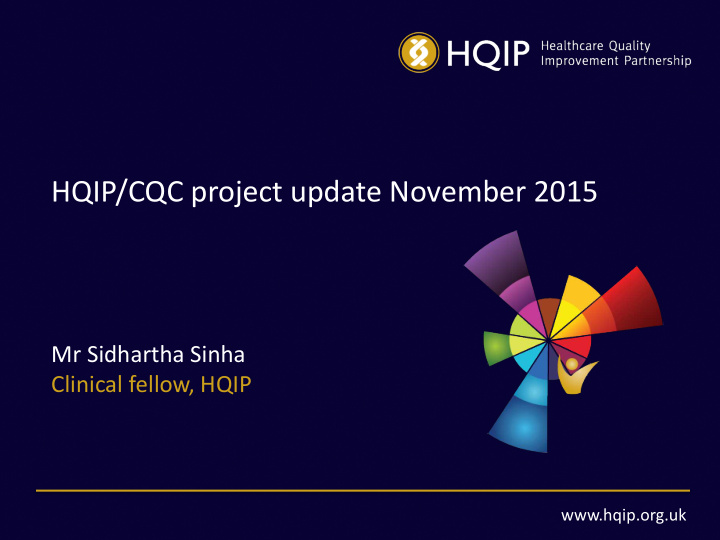



HQIP/CQC project update November 2015 Mr Sidhartha Sinha Clinical fellow, HQIP www.hqip.org.uk
Overview • Rationale • Methodology • Phase 1 (“Key” metrics) • Phase 2 (data slides) • Issues and concerns
Preface
Rationale (I) • CQC Optimisation of NCA data use for inspections Format of inspections Format of data/data flow Numbers of inspections Ease of access to data Time-scale of inspections Volume of NCA data Breadth of inspection teams Relevance of data Pre-inspection Data Pack (PIDP) Contemporaneousness of data
Rationale (II) • CQC use of NCA data
Rationale (III) • End goals of project (I)
Rationale (IV) • CQC PIDPs… •Not all audits being used •Selected metrics being used
Rationale (V) • End goals of project (II)
Rationale (VI) • HQIP
Rationale (VII) • Solutions (?) Reduction Rationalisation Co-localisation Standardisation Simplification
Rationale (VIII)
Methodology (I) • Steering Group
Methodology (II) • Remit
Phase 1 (“Key” metrics) (I) • June-September 2015 Meeting with NCA providers Clinical and Management Leadership 1) Ability to participate 2) Selection of key metrics 3) Discussions about data flow
Phase 1 (“Key” metrics) (II) Current annual data Outcomes>Process>Structure>PREMS Up to 5 metrics Avoid duplication Avoid composites Importance or variability CQC’s 5 key questions Evidence-based standards Methodology and robustness Hospital or Trust level No new metrics or analyses Ratified by NCA providers
Phase 1 (“Key” metrics) (III)
Phase 2 (data slides) (I) Key metrics from audit Master spreadsheet by HQIP/CQC Finalise data slide format Sample data slides by CQC Agree format of data flow Start of actual data flow
Phase 2 (data slides) (II) CQC KEY QUESTION • SPO • DEFINITION • RATIONALE • CRUDE OR RISK-ADJUSTED • RISK-ADJUSTMENT METHODOLOGY • NUMERICAL FORM (C/Is, %) • UNIT OF ANALYSIS • OUTLIERS DEFINED WITH STATISTICAL TEST • RANKING USING PERCENTILE SCALE • DISPLAY FORMAT • NATIONAL AGGREGATE • NATIONAL STANDARD/GUIDELINE • MAPPING TO STANDARD OR GUIDELINE • SAMPLING METHODOLOGY • SAMPLING PERIOD • CASE ASCERTAINMENT •
Phase 2 (data slides) (III) Standardisation of presentation within PIDP 1 slide per audit Standard grouping of metrics Numerical data + graphics Clear labelling, distinctiveness Context*
Sacred Heart Hospital- Hip Fracture Audit Red : ≤25th percentile National National 2013 2014 Amber : >25th, ≤75th percentiles Metric Standard Aggregate (Jan- (Jan- Green : >75th percentile (CQC Domain) (NICE (England Dec) Dec) Black circle is 2014, grey circle is 2013 guidelines) Proportion) Blue line refers to national aggregate Crude proportion of patients having surgery on the day or day after admission 60.2% 70.6% 100% 74.6% (Effective) Crude perioperative medical assessment 85.4% 79.4% 100% 91.4% (Effective) 18.7 14.2 Crude overall hospital length of stay. 20.1 days n/a (Effective and Responsive) days days (England Mean) Crude percentage of patients 98.8% 98.5% n/a 98.0% documented as not developing a pressure ulcer (Safe) Is this hospital a statistical outlier? Awaiting Data Risk-adjusted 30-day mortality (Effective) Yes/No Case Ascertainment 97.4% 95.8% n/a 93.5% n/a (Effective and Well-led) Number of cases submitted to audit: 383 Source: National Hip Fracture Database 2015
Phase 2 (data slides) (IV)
Sacred Heart Hospital- Hip Fracture Audit Metric Context Context Context Context (CQC Domain) Crude proportion of patients having surgery on the day or day ? ? ? ? after admission (Effective) Crude perioperative medical ? ? ? ? assessment (Effective) Crude overall hospital length of ? ? ? ? stay. (Effective and Responsive) Crude percentage of patients documented as not developing a ? ? ? ? pressure ulcer (Safe) Risk-adjusted 30-day mortality ? ? ? ? (Effective) Case Ascertainment ? ? ? ? (Effective and Well-led) Number of cases submitted to audit: 383 Source: National Hip Fracture Database 2015
Sacred Heart Hospital- Hip Fracture Audit Metric Data Completion Mapping to Outlier Metric Specific Free Text SPO Rationale National / % Incomplete National Definition Guideline (CQC Domain) Guideline Records Crude proportion of patients having surgery on the day or NICE QS 16, Exact P XXXX XXXX N/A XXXX statement 5 day after admission (Effective) NICE CG: Crude perioperative medical NICE CG 124, XXXX XXXX Approximate N/A XXXX P section 1.8; BPT assessment (Effective) BPT: Approximate Crude overall hospital length O XXXX N/A N/A XXXX N/A XXXX of stay. (Effective and Responsive) Crude percentage of patients documented as not O XXXX N/A N/A XXXX N/A XXXX developing a pressure ulcer (Safe) O N/A XXXX N/A XXXX XXXX XXXX Risk-adjusted 30-day mortality (Effective) Case Ascertainment XXXX XXXX XXXX N/A N/A N/A N/A (Effective and Well-led) Sampling methodology = total target Predicted date of next data feed to CQC = xxxx Link to hospital x “QI webpage for FFFAP NHFD” Source: National Hip Fracture Database 2015
An NCA Dashboard Duplication? Purpose? Format? Content? Audience? Expectations?
Concerns from audit suppliers Data reductionism and complex care pathways / services “Equal” weighting to all audits Additional (duplicative) data flow / resources Based on annual (rather than more frequent) reporting Inherent differences between QI and QA CORP methodological concerns
Challenges encountered so far… Creating a comprehensive reference resource Optimising the format of the data slide English aggregate vs UK aggregate National aggregates vs regional network aggregates
Challenges for the future… Changes to the CQC inspection / monitoring format Reduction in the NCAPOP funding envelope
Summary • We have begun a process to try to optimise the way in which CQC is using NCA data for inspections • There may be scope to expand this optimised data flow into a resource for Trusts and other stakeholders • Your feedback on both of these processes would be greatly appreciated!
Table discussions • 8 tables (4 topics); CQC will rotate through • Printed sample slides and related documents will be available on each table 1. Feedback on the optimisation process for the CQC 2. Feedback on whether an NCA dashboard is desirable or not • Not prescriptive; 75 mins • Can each table please nominate – 1. A scribe to make some notes on the A1 paper supplied 2. A representative to summarise discussion to the floor (5 mins)
Recommend
More recommend